close 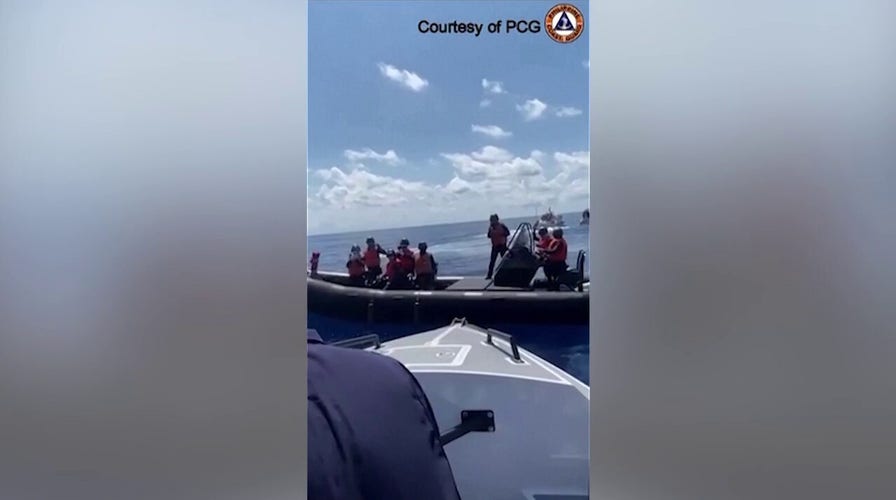
WATCH: Chinese rubber boat blocks Philippines coast guard in the middle of a medical evacuation
Chinese vessels harassed and blocked members of the Philippines coast guard who were attempting the medical evacuation of a sick crew member. (Philippine Coast Guard)
Join Fox News for access to this content Plus special access to select articles and other premium content with your account – free of charge. By entering your email and pushing continue, you are agreeing to Fox News’ Terms of Use and Privacy Policy, which includes our Notice of Financial Incentive. Please enter a valid email address. By entering your email and pushing continue, you are agreeing to Fox News’ Terms of Use and Privacy Policy, which includes our Notice of Financial Incentive. Having trouble? Click here.
TAIWAN – China is inching closer to acts of war in the seas near the Philippines, according to experts, who say Beijing’s amplified hostile moves may soon cross red lines that could force the treaty-bound United States to intervene and defend the Asian nation.
“The Chinese are intentionally taunting the Philippines… which Beijing needs to justify an escalation,” Andrew J. Masigan, a Philippine Star columnist and special consultant to the Middle East Media Research Institute’s (MEMRI) Chinese Media Studies project, told Fox News Digital. “Every time the Philippines makes a move, China escalates… for instance, when the Philippines adds two Coast Guard vessels, the Chinese will add six.” But Masigan says his nation will not “fall into this Chinese trap,” and will continue to follow international law while working to strengthen the U.S.-Australia-Philippines-Japan alliance and increase cooperation with Taiwan, Vietnam and Malaysia.
The People’s Republic of China (PRC) claims roughly 90% of the South China Sea, with Philippines Defense Secretary Gilberto Teodoro Jr. telling the media that China is converting the region into the “Lake of China.”
A TIMELINE OF CLASHES BETWEEN CHINA AND THE PHILIPPINES IN SOUTH CHINA SEA, FOLLOWING LATEST SHIP COLLISION
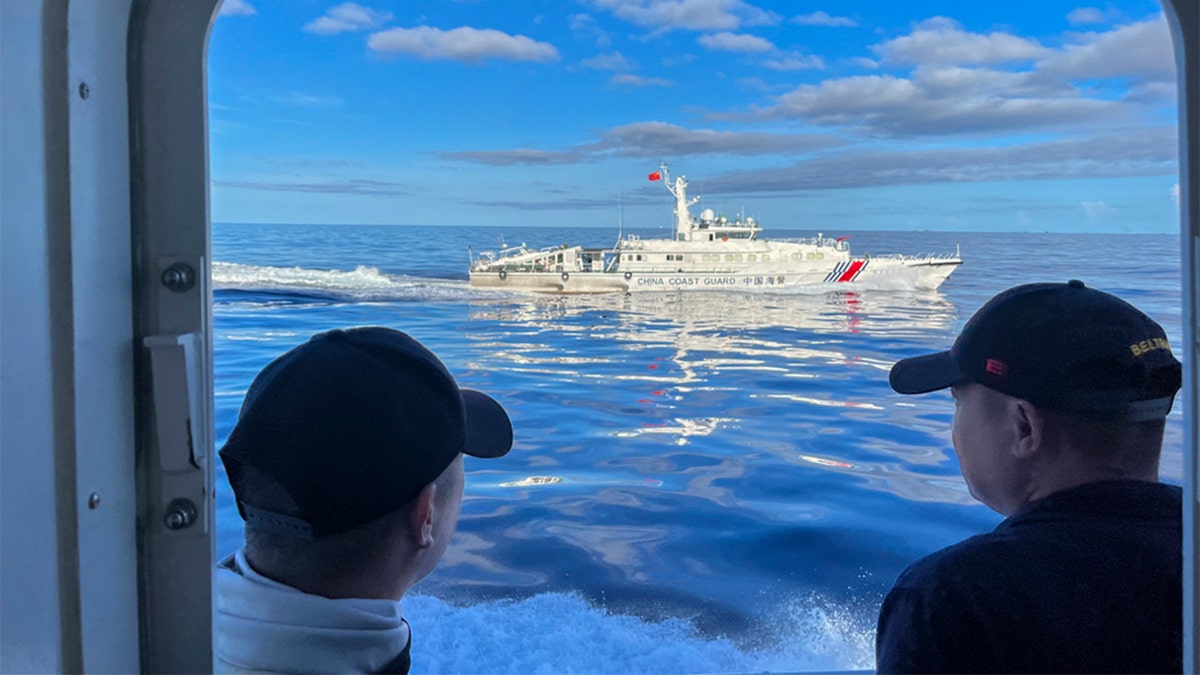
A Chinese Coast Guard ship approaches a Philippine ship, foreground, causing a minor collision, in the vicinity of Second Thomas Shoal on March 5, 2024. (Philippine Coast Guard via AP)
Philippine President Ferdinand Marcos Jr. recently spelled out what Chinese control of these waterways would mean, noting, “There is no such thing as a regional issue any longer… the South China Sea is the passageway for half of the world’s trade and therefore the peace and stability of the South China Sea and the freedom of navigation of South China Sea is a world issue.”
Chinese Navy or Coast Guard ships harass Taiwanese or Vietnamese fishing boats on a near-daily basis, but since the end of 2023, Beijing has significantly turned up the heat on the Philippines. The Chinese have fired military-grade lasers and high-powered water cannons at both civilian and Philippine Coast Guard ships. Other hostile PRC actions include encircling, blocking and even ramming Philippine vessels.
China’s People’s Liberation Army Navy (PLAN) now has the largest number of active warships in the world, and China’s Coast Guard, a paramilitary force with over 160 armed vessels and numerous patrol boats, has stepped up confrontations with Filipino fishermen, as well as the Philippine Coast Guard. China also makes use of a “maritime militia,” fishing boats with deputized personnel equipped by the Chinese military.
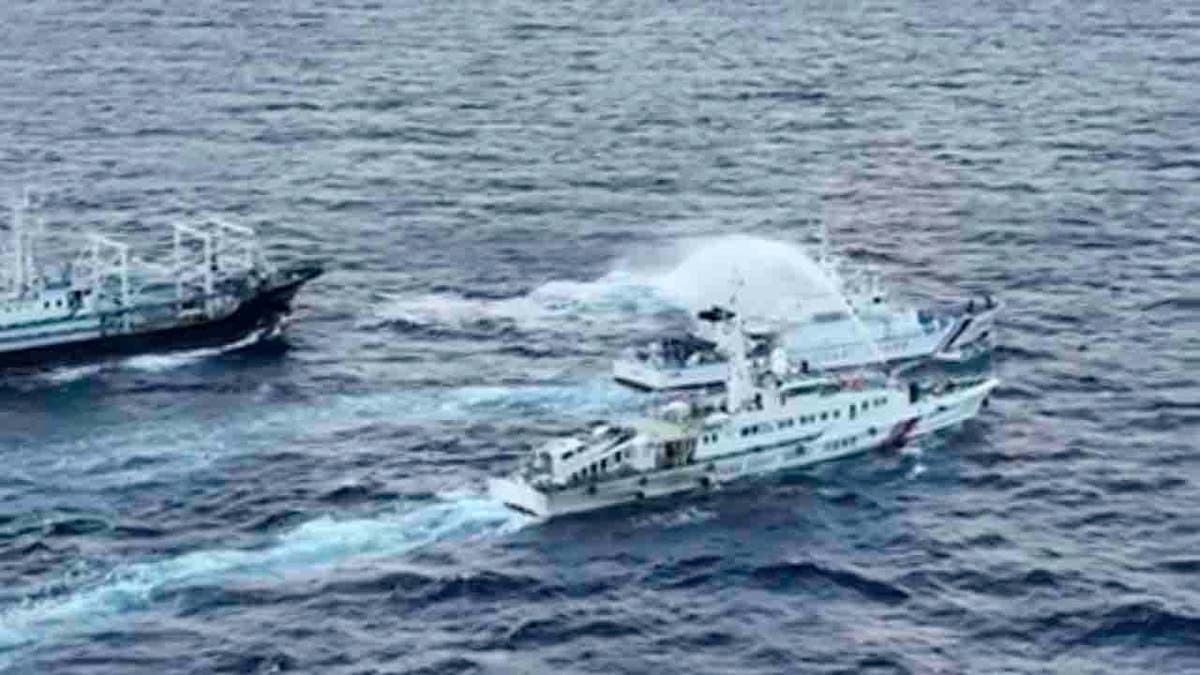
A Chinese Coast Guard ship uses a water cannon on a Philippine patrol ship, BRP Cabra as it approaches Second Thomas Shoal, locally known as Ayungin Shoal, in the disputed South China Sea on Dec. 10, 2023. (Philippine Coast Guard via AP)
President Marcos has repeatedly called on China to dial down its aggressive moves, warning that should a Philippine citizen (military or civilian) lose their life in one of these confrontations, “we would have crossed the Rubicon.”
The major area of friction is in the Spratly Island chain. These features (most of which don’t meet international law criteria to be called “islands”) are claimed in totality by Beijing, as well as by Taiwan. Taiwan holds several islands but mostly pays lip service to its claims.
Taiwan is officially the Republic of China (ROC), and the ROC constitution makes essentially the same territorial claims communist China makes. This is absurd to most in Taiwan, but should they be changed, China would accuse Taiwan of “declaring independence” and war would almost immediately follow.
CHINESE COAST GUARD BLOCKED MEDICAL EVACUATION, PHILIPPINES SAYS: ‘BARBARIC AND INHUMANE’
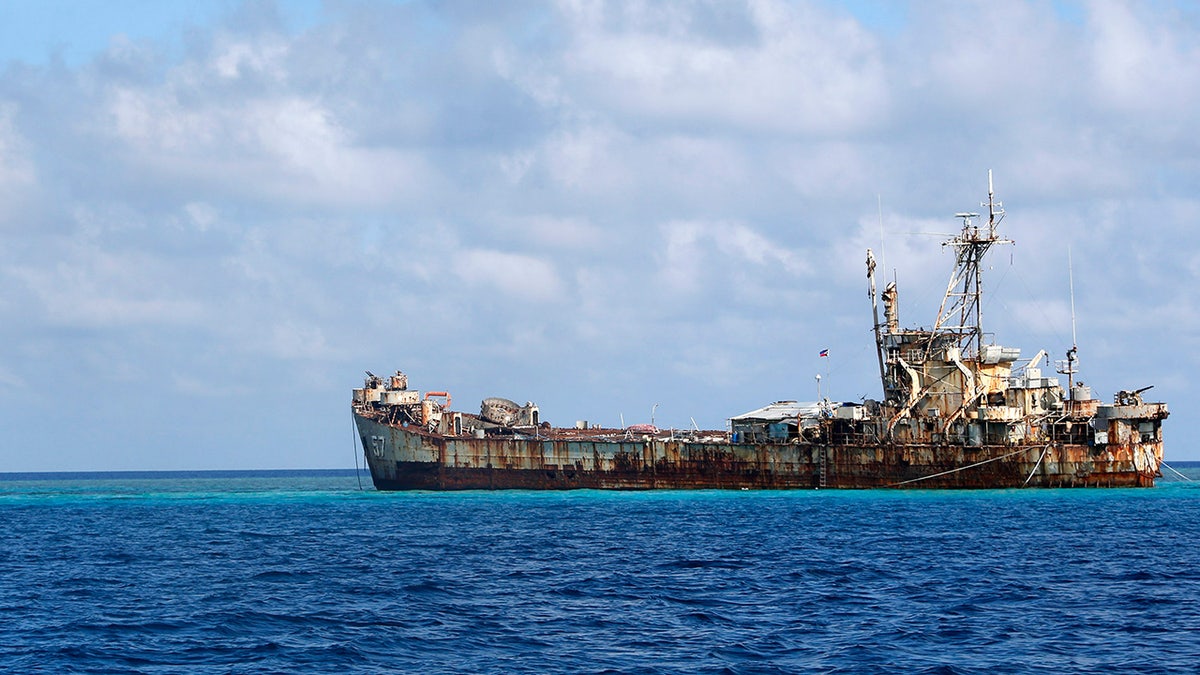
A Chinese Coast Guard vessel patrols near the BRP Sierra Madre, a marooned transport ship that Philippine marines live on as a military outpost, in the disputed Second Thomas Shoal, part of the Spratly Islands in the South China Sea, March 30, 2014. (Reuters/Erik De Castro)
Certain shoals, islets or even rocky outcroppings in the Spratly Islands are also claimed by Malaysia, Vietnam and the Philippines. But out of all these claimants, only China has taken significant moves to militarize the islands it holds or is building.
In 1999, a U.S.-built, World War II-era landing craft belonging to the Philippine Navy was intentionally grounded on the Second Thomas Shoal, a tiny submerged reef in the South China Sea, or the West Philippine Sea, a term favored by the Philippines.
This rusting hulk, the BRP Sierra Madre, is a symbolic outpost representing Philippine sovereignty, and a handful of Philippine marines are stationed on board. At the end of December 2023, China sent 27 vessels to encircle the Second Thomas Shoal to prevent the ship from being resupplied.
The deliberate beaching of the BRP Sierra Madre was done, the Philippines says, after China built structures on Mischief Reef, an atoll located roughly 130 nautical miles from the Philippines’ Palawan Province in the mid-1990s.
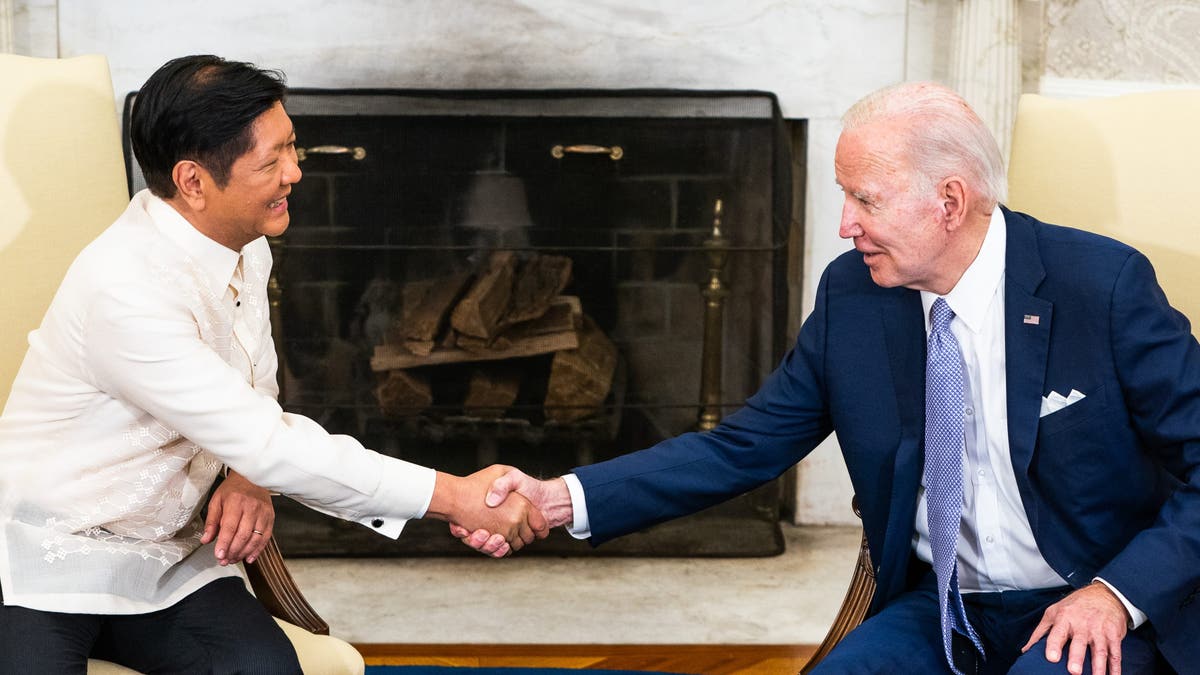
President Biden and Philippines President Ferdinand R. Marcos Jr. meet in the Oval Office on May 1, 2023. (Demetrius Freeman/The Washington Post via Getty Images)
Today, the Chinese-occupied Mischief Reef is a large artificial island complete with many types of military equipment, including anti-aircraft missiles, and an airfield with an 8,900-foot runway. In 2016, a Chinese commercial jet landed on what was once a few rocks surrounding a lagoon.
Mischief Reef is just one of several artificial islands China has built in the South China Sea; military bases from which it can enforce its “nine-dash-line.”
These are nine lines drawn on a 1946 map of the South China Sea that claim everything from Taiwan to not far off the coast of Vietnam, and to the east, the lines encroach upon the beaches of the Philippines.
PHILIPPINES WARNS OF ‘RED LINE’ WITH BEIJING AMID HEIGHTENED TENSIONS IN SOUTH CHINA SEA
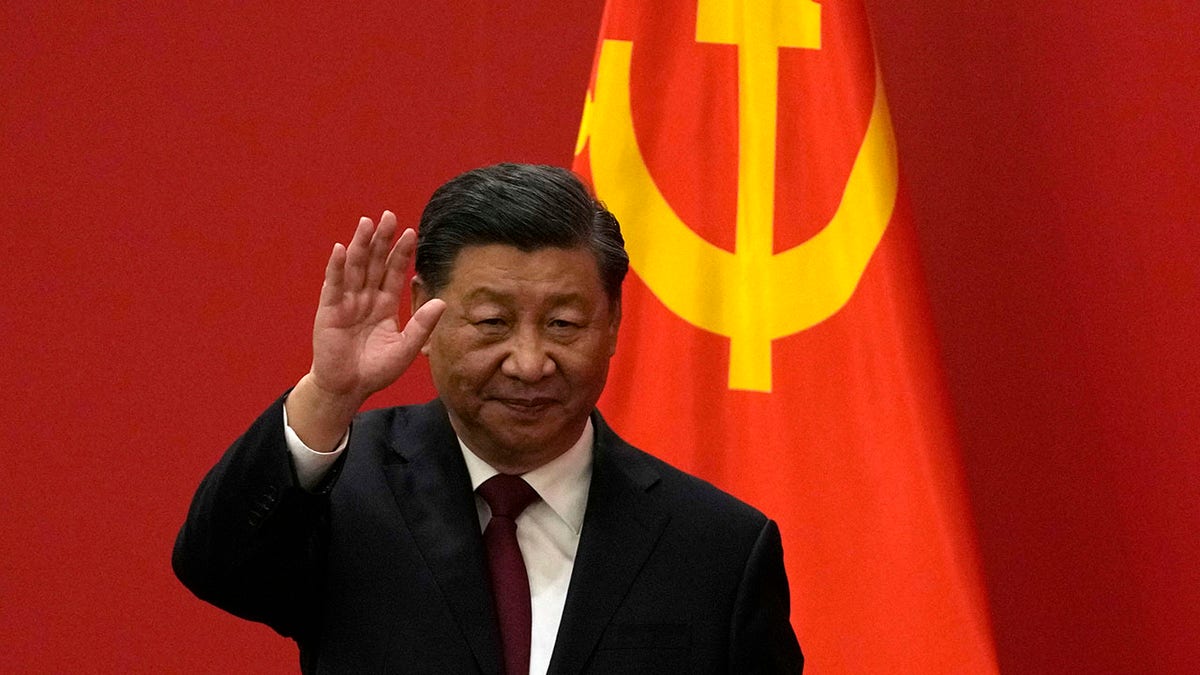
Chinese President Xi Jinping waves during an event at the Great Hall of the People in Beijing on Oct. 23, 2022. (AP Photo/Andy Wong, File)
In 2023, China added yet another line to what it calls “inseparable parts of China.” It’s now the “ten-dash-line,” which is raising serious concerns about Beijing’s ambitions.
“An important issue with China’s multiplying dashed lines is that it’s not clear what they include,” Taipei Times columnist Michael Turton told Fox News Digital, echoing sentiments common among China watchers. “Will 10 lines become 20 over the next few years? Will China claim the dark side of the moon, now that they’ve landed a probe there?” Turton asks.
Dean Karalekas, author of “Civil-Military Relations in Taiwan: Identity and Transformation,” told Fox News Digital, “Taiwan is the prize. But China’s military hasn’t tasted combat in decades.” Bullying the relatively militarily weak Philippines, however, “could be how the untested Chinese Navy acquires a bit of combat experience,”
Karalekas says, “Beijing wonders whether America has the stomach for another war. A good litmus test for this is whether the U.S. Navy responds to a clear casus belli against the Philippines – a U.S. treaty ally with whom there is no ambiguity – strategic or otherwise.”
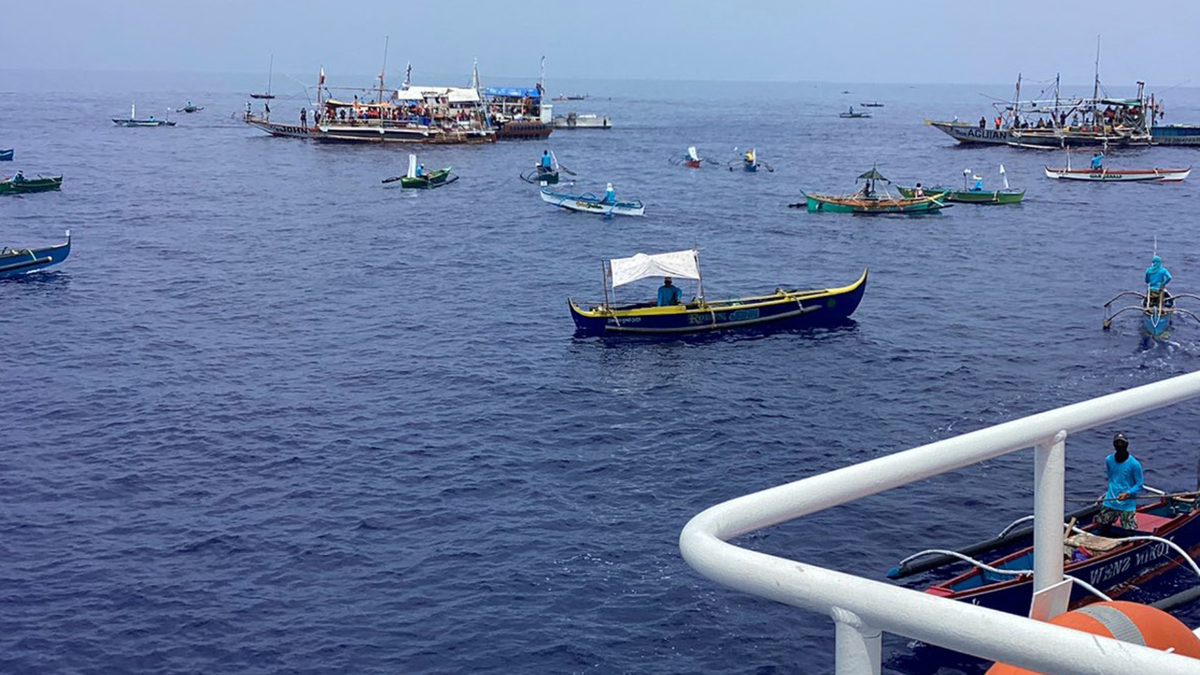
Fishing boats carrying activists and volunteers belonging to a nongovernment coalition called Atin Ito, Tagalog for This is Ours, pass by waters off Palauig Point, Zambales province, northwestern Philippines as they head toward Scarborough Shoal on May 15, 2024. (Philippine Coast Guard via AP)
If a Chinese move against the Philippines doesn’t trigger a military response from Washington despite its clear treaty obligations there, “then Beijing may interpret this to mean that the U.S. is unlikely to go to bat for Taiwan, especially now, with a Biden administration that just projects weakness.”
Karalekas noted that would allow “China to gauge America’s response time, observe their tactics, and develop invaluable experience fighting the U.S. Navy, in a low-stakes conflict they can easily withdraw from without losing face.”
CHINA SENDS WARPLANES, BOATS AROUND TAIWAN FOLLOWING PHONE CALL BETWEEN XI AND BIDEN
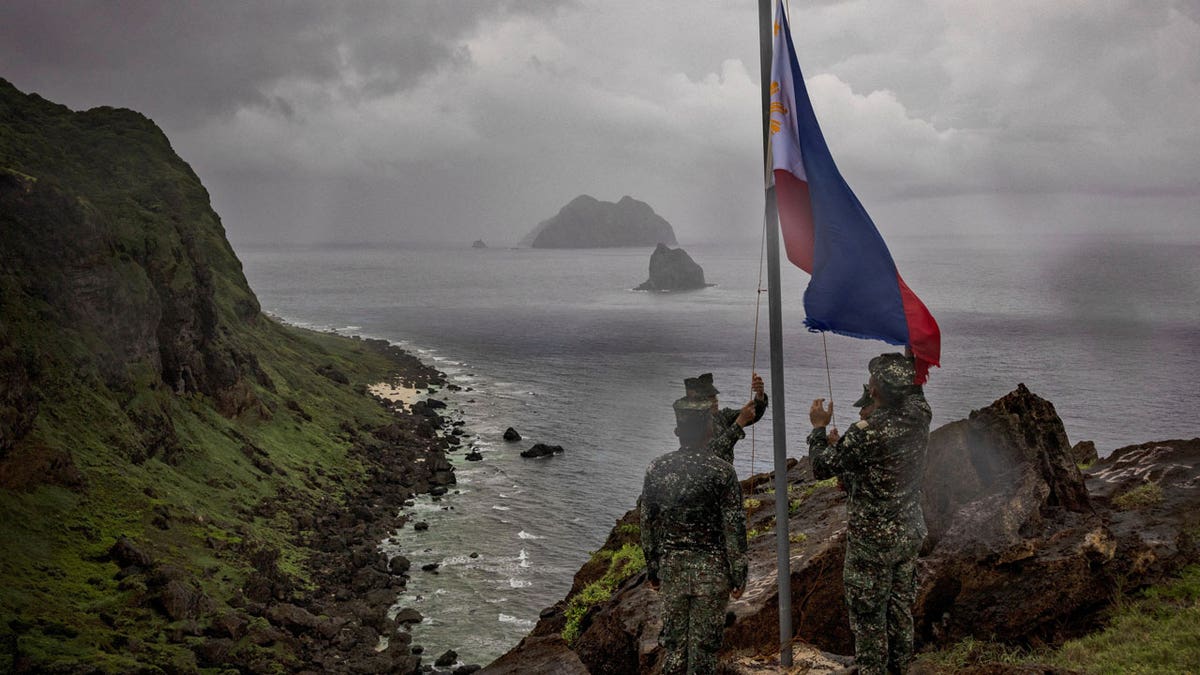
Filipino soldiers on Mavulis Island during a trip by the chief of staff of the Armed Forces of the Philippines, in Batanes, Philippines, June 29, 2023. Batanes, a group of islands at the country’s northernmost tip, lies just 140 kilometers from Taiwan. (Ezra Acayan/Pool via Reuters/File Photo)
China’s actions have led to countermoves. The U.S., Philippine, Japanese, and Australian militaries are discussing closer cooperation. The U.S. now has access to nine temporary bases in the Philippines (and more are being built on the Philippine islands closest to Taiwan). Taiwan and the Philippines have been working on training cooperation since 2021. In April this year, Taiwan confirmed that it plans to sign a more comprehensive agreement with the Philippines to strengthen mutual maritime security. On June 15, Taiwan launched a new, 4000-ton Coast Guard vessel that comes equipped with three high-pressure water cannons with a range of 120 meters to perform “dispersal tasks,” Taiwanese authorities said.
There is no South China Sea version of NATO and the fact that Taiwan, the Philippines, Malaysia and Vietnam all have overlapping claims, experts agree, does play into China’s divide-and-conquer strategy. But in comments to Fox News Digital, MERMI’s Anna Mahjar-Barducci noted that while the Philippine Navy “monitors” Vietnam’s island-building activities in waters within Manila’s exclusive economic zone, her nation’s military is focused on China.
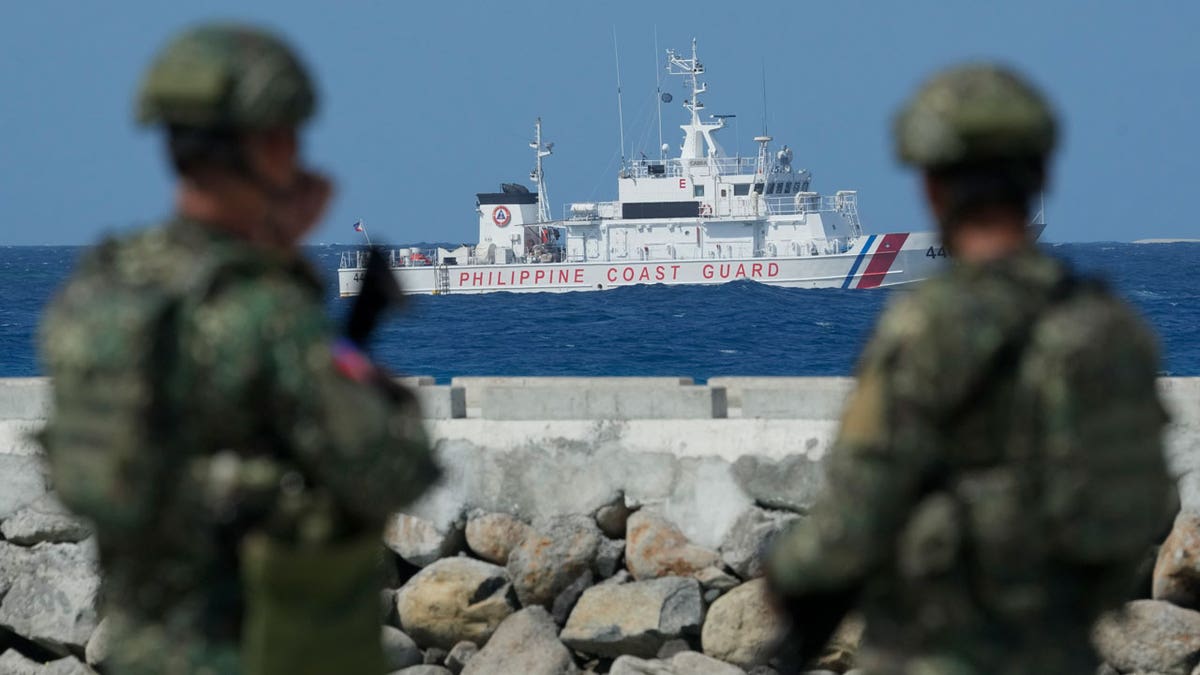
Philippine troops watch a Philippine Coast Guard ship as they secure an area at the Philippine-occupied Thitu island, locally called Pag-asa island, on Dec. 1, 2023, in the disputed South China Sea. (AP Photo/Aaron Favila, File)
She cited Philippine Navy spokesman Commodore Roy Vincent Trinidad who said, “Vietnam does not initiate illegal, coercive, aggressive, and deceptive actions against us, unlike China.” Philippine Coast Guard spokesman Jay Tarriela agrees, noting that “Vietnam focuses on minding their own affairs… They do not engage in harassing our fishermen or illegally deploying Coast Guard vessels and maritime militia in the waters surrounding our occupied maritime features.”
Earlier this month, the Chinese Coast Guard dumped food, meant for the marines aboard the Sierra Madre, into the ocean. When asked to comment on the situation on the Second Thomas Shoal, Chinese officials parroted the party line: that the area belongs to China and the Philippine ship must be towed away.
CLICK HERE TO GET THE FOX NEWS APP
The U.S. is reportedly considering giving the Philippines military drones, transport aircraft, and other defense systems. President Marcos, who visited Washington in April, told the press that while he does not believe a full-scale conflict with China is imminent or inevitable, he wants Beijing to understand that there is a red line, which once crossed, will result in a military response.
This military response may happen faster than previously thought. On Monday, July 17, a Philippine sailor reportedly sustained severe injuries after Chinese ships once again blocked a Philippines resupply mission to the BRP Sierra Madre. The details of the incident are not fully clear, but it appears Chinese ships may have again rammed Philippine vessels, and in what reportedly is a new tactic, Chinese ships also attempted to tow away Philippine vessels. How seriously the sailor was injured is unknown, but “red lines” may have already been crossed.
Eryk Michael Smith is a Taiwan-based correspondent who since 2007, has worked both as a broadcast journalist for the island’s only English-language radio station, ICRT, as well as with numerous other publications and local news outlets. Smith’s journalism focuses on Taiwan-China relations, local politics, as well as science and technology developments in the greater China region. He is based in Taiwan’s largest southern city, Kaohsiung. He can be followed @ErykSmithTaiwan
